Varicose Veins
What are varicose veins?
● How are varicose veins formed?
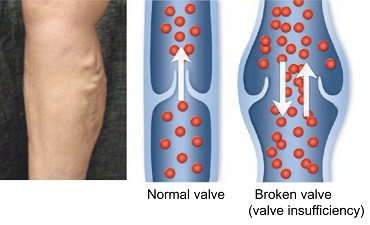
Varicose vein is a leg vessel disease. Inside your veins are valves that prevent blood from flowing backward down the legs when you are in an upright position. When these valves malfunction, blood flows backward and accumulates in the veins below. If this condition continues day in and day out, overtime venous walls are stretched and the veins bulges. As veins continue to bulge, they will eventually wind like snakes; these winding veins are called “varicose veins”. Varicose veins occur in superficial veins1; they do not occur in deep veins2.
Varicose veins are aesthetically unpleasant; and the accumulation of dirty blood and/or increased intravenous pressure can cause inflammation that could lead to other symptoms.
1. Superficial veins run below the skin surface.
2. Deep veins are buried deep in the legs and run between muscles.
● Signs of Onset: swelling and heaviness
Most symptoms of varicose veins occur in the calves, especially toward late afternoon and evening, the swelling and feeling of heaviness become more apparent. That said, degenerative arthritis of the knees and spinal canal stenosis could also cause swelling and heaviness in the legs. Consult a doctor if you are concerned.
● Symptoms
- Veins are standing out
- Heaviness feeling in the calf
- Swelling
- Cramps
- Legs feel hot
- Tickling
- Itchiness and rashes
- Discoloration
- Ulcerous
● Symptoms that could be of disease other than varicose veins
- Cold feet
- Difficulty taking stairs
- Difficulty sitting on your calves
- Calves feel heavy when you walk
- Legs feel numb
- Soles feel like they are on gravel
- Itchy legs in the winter
What do varicose veins look like?
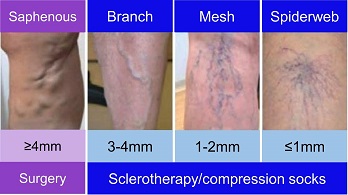
The word varicose comes from the Latin word varicosus, which means full of dilated veins; and the word varicosus originates from the Latin word varix, meaning dilated veins.
Varicose veins are classified into four categories based on their visible size: saphenous, branch, mesh, and spiderweb. Only saphenous varicose veins that are symptomatic require surgical treatment, the other three types of varicose veins are mild and of little concern.
Who is more likely to develop varicose veins?
One in ten people develops varicose veins; it is a common disease.
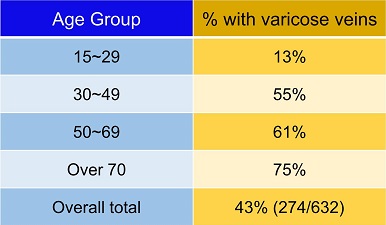
Varicose veins are more common in women over the age of 40, and this likelihood increases with age. In Japan, varicose veins are found in 43% of men and women over the age of 15, and in 62% of those over the age of 303.
A study of people over 40 reported 8.6% (3.8% of men and 11.3% of women) having varicose veins; this is over 10 million people in estimation4. Also, one in every two women who have had birthing experience developed varicose veins5. Although varicose veins are still not widely recognized, they are actually a very common disease.
3. 平井正文,久保田仁,川村陽一他 脈管学28:4 l 5-420, l 989
4. 小西ら 2005年西予地区コホー ト研究(愛媛県西部の1市5町の40歳以上の住民を対象として愛媛大学公衆衛生学教室 小西正光教授によって2002年から勧められている調査)脳卒中および心筋梗塞既往者を除外した 9,123人(男性3,302人、女性5,821人、平均年齢62.4歳)における 「下肢表面が盛り上がって蛇行している血管で、かつ起立すると目立つもの」と定義された静脈瘤(表在性静脈瘤:伏在、側枝、網目の一 部と考えられる)の出現頻度です。
5. 平井正文,牧篤彦,早川直和:妊娠と静脈瘤静脈学:255-261,1997
What treatment options are there?

There are five main types of treatment for varicose veins. Treatment varies depending on the type of varicose veins and the patient’s condition. Each type of treatment has its own merits and cautions. Your doctor will help you choose the appropriate treatment for your type of varicose veins.
● Stripping
Stripping is a surgical procedure where the doctor makes an incisions of 1 to 3cm each in the groin area and behind the knee for the insertion of a fine wire into the problem vein. The wire is then pulled out, removing the problem vein with it. The procedure is usually performed under general anesthesia or spinal anesthesia, and admission is necessary. Since all diseased blood vessels are removed, it is highly therapeutic. However, compared to endovascular treatments, the wound is larger and as is burden on the body. Therefore, it takes longer to recover, and there is a risk of pain and bleeding after the surgery.
● Endovenous Thermal Ablation
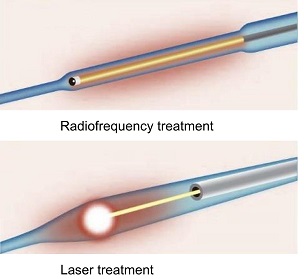
Endovenous thermal ablation is a treatment in which the vein is burned and closed off instead of being pulled out as in stripping. A thin tube (catheter) is inserted into the diseased vein and cauterized by applying heat from the inside. The burned veins are absorbed and disappear in about six months after the treatment. This is a minimally invasive treatment performed under local anesthesia, and you can go home a few hours after the procedure6. There are two types of endovenous ablation treatment: high frequency (radiofrequency) treatment using high-frequency electric current and laser treatment using a laser. Both radiofrequency and laser treatments are covered by Japanese insurance.
6. Subject to the doctor’s diagnosis.
● VenaSeal
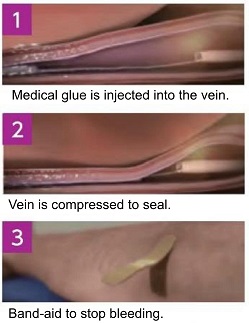
In December 2019, Japanese national insurance began coverage for endovenous adhesive treatment (VenaSeal). VenaSeal (glue) was developed specifically for use in lower limb veins. With the use of a catheter, the seal is injected into the blood vessel and close it off. In contrast to endovenous thermal ablation which uses heat to close off the blood vessels, VenaSeal does not involve heat, and is thus less painful and less impact on surrounding tissues such as burns and nerve damage.
In addition, as TLA anesthesia7–used in endovenous thermal ablation against heat-induced pain and complications–is not necessary, there are fewer needle insertions, less pain during anesthesia infiltration, and no need for postoperative compression. However, since glue is injected into the blood vessel, those with allergies or have allergic reactions to glue might not be candidate for this type of treatment.
7. TLA is short for Tumescent Local Anesthesia (low concentration high volume infiltration anesthesia). It is injected directly into the treating vein during endovenous thermal ablation to reduce pain and to protect tissues surrounding the ablated area.
● Sclerotherapy
In sclerotherapy, a drug is injected into the varicose vein to congeal it. It is called sclerotherapy because just as the suffix sclero- suggests, the congealed vein hardens. The hardened veins are absorbed and disappear in about six months. The procedure can be performed in about 10 minutes in outpatient. It is a highly effective treatment for mild varicose veins, but may not be as effective for advanced varicose veins. In addition, allergy and pigmentation from the drug may occur.
● Preservation Therapy
Preservation therapy does not rely on surgical procedure or medication in treating varicose veins. It consists of improving lifestyle habits through exercises and massages, and wearing of compression socks. Unlike the other forms of treatment mentioned above, preservation therapy does not cure. Compression socks apply pressure on the legs and help the calf muscles in squeezing, thereby stimulating venous return and preventing blood from pooling in the legs. When worn properly, they can be very helpful in relieving the symptoms of varicose veins. Some people find the tight socks uncomfortable, but once you are used the initial discomfort, you will find them quite relieving. Also, the tightness might give some people rashes.
What can I do to avoid severe varicose veins?
Varicose veins are a disease that progresses gradually without being noticed. To prevent further progression and worsening of the disease, please keep the following points in mind.
● Maintaining a habit of moderate exercises
Maintain a habit of doing moderate exercises even on you days off. Moving your body improves blood flow, increases muscle strength in the legs, and prevents varicose veins in the lower limbs. However, try to avoid strenuous exercises or long distance jogs/runs.
● Eating well-balanced meals
A healthy and well-balanced diet is just as important as moderate exercises. Instead of a high salt and fatty diet, a well-balanced diet can help to reduce varicose vein risk factors such as obesity and high cholesterol, as well as to help improve blood flow and reduce the burden on the veins.
● Wearing comfortable underwear
Girdles and tight underwear might help you slip into slim bottoms easier, but they could also restrict blood circulation in the lower part of the body and cause varicose veins to progress. High heels also reduce blood circulation since the calf muscles are not being used fully when walking. To prevent poor circulation, wear comfortable shoes if you plan to be on your feet or walking for a sustained period of time.
● Using compression socks or stockings
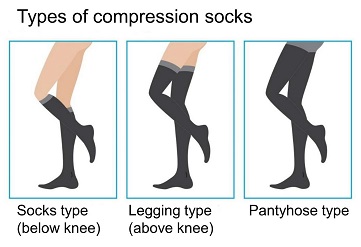
Compression socks are special medical socks that effectively maintain blood circulation by applying gradual pressure from the ankles to the calves and/or thighs. They are useful in preventing varicose veins and their progression, and they are also useful in post-treatment care in preventing swelling. When you purchase compression socks, please make sure they are the proper size and type, and wear them properly. If you are unsure about what size and which type is best for you, consult a doctor.



